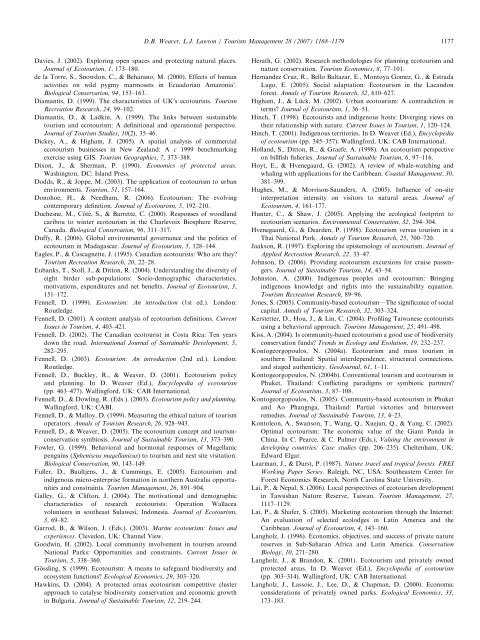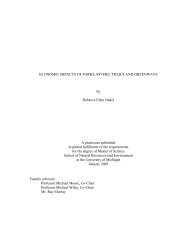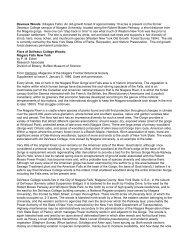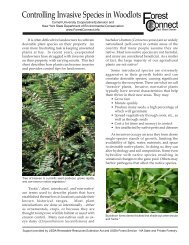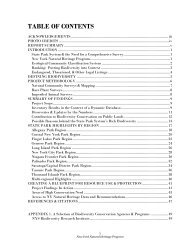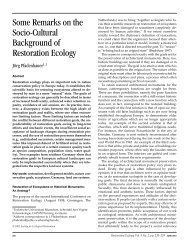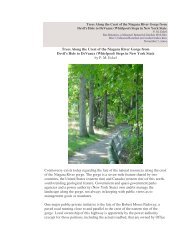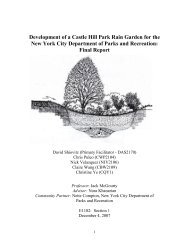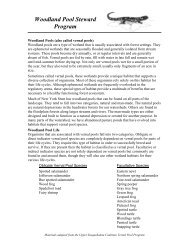Twenty years on: The state of contemporary ecotourism research
Twenty years on: The state of contemporary ecotourism research
Twenty years on: The state of contemporary ecotourism research
- No tags were found...
Create successful ePaper yourself
Turn your PDF publications into a flip-book with our unique Google optimized e-Paper software.
ARTICLE IN PRESSD.B. Weaver, L.J. Lawt<strong>on</strong> / Tourism Management 28 (2007) 1168–1179 1177Davies, J. (2002). Exploring open spaces and protecting natural places.Journal <strong>of</strong> Ecotourism, 1, 173–180.de la Torre, S., Snowd<strong>on</strong>, C., & Beharano, M. (2000). Effects <strong>of</strong> humanactivities <strong>on</strong> wild pygmy marmosets in Ecuadorian Amaz<strong>on</strong>ia’.Biological C<strong>on</strong>servati<strong>on</strong>, 94, 153–163.Diamantis, D. (1999). <strong>The</strong> characteristics <strong>of</strong> UK’s ecotourists. TourismRecreati<strong>on</strong> Research, 24, 99–102.Diamantis, D., & Ladkin, A. (1999). <strong>The</strong> links between sustainabletourism and <strong>ecotourism</strong>: A definiti<strong>on</strong>al and operati<strong>on</strong>al perspective.Journal <strong>of</strong> Tourism Studies, 10(2), 35–46.Dickey, A., & Higham, J. (2005). A spatial analysis <strong>of</strong> commercial<strong>ecotourism</strong> businesses in New Zealand: A c 1999 benchmarkingexercise using GIS. Tourism Geographies, 7, 373–388.Dix<strong>on</strong>, J., & Sherman, P. (1990). Ec<strong>on</strong>omics <strong>of</strong> protected areas.Washingt<strong>on</strong>, DC: Island Press.Dodds, R., & Joppe, M. (2003). <strong>The</strong> applicati<strong>on</strong> <strong>of</strong> <strong>ecotourism</strong> to urbanenvir<strong>on</strong>ments. Tourism, 51, 157–164.D<strong>on</strong>ohoe, H., & Needham, R. (2006). Ecotourism: <strong>The</strong> evolvingc<strong>on</strong>temporary definiti<strong>on</strong>. Journal <strong>of</strong> Ecotourism, 5, 192–210.Duchesne, M., Coˆté, S., & Barrette, C. (2000). Resp<strong>on</strong>ses <strong>of</strong> woodlandcaribou to winter <strong>ecotourism</strong> in the Charlevoix Biosphere Reserve,Canada. Biological C<strong>on</strong>servati<strong>on</strong>, 96, 311–317.Duffy, R. (2006). Global envir<strong>on</strong>mental governance and the politics <strong>of</strong><strong>ecotourism</strong> in Madagascar. Journal <strong>of</strong> Ecotourism, 5, 128–144.Eagles, P., & Cascagnette, J. (1995). Canadian ecotourists: Who are they?Tourism Recreati<strong>on</strong> Research, 20, 22–28.Eubanks, T., Stoll, J., & Ditt<strong>on</strong>, R. (2004). Understanding the diversity <strong>of</strong>eight birder sub-populati<strong>on</strong>s: Socio-demographic characteristics,motivati<strong>on</strong>s, expenditures and net benefits. Journal <strong>of</strong> Ecotourism, 3,151–172.Fennell, D. (1999). Ecotourism: An introducti<strong>on</strong> (1st ed.). L<strong>on</strong>d<strong>on</strong>:Routledge.Fennell, D. (2001). A c<strong>on</strong>tent analysis <strong>of</strong> <strong>ecotourism</strong> definiti<strong>on</strong>s. CurrentIssues in Tourism, 4, 403–421.Fennell, D. (2002). <strong>The</strong> Canadian ecotourist in Costa Rica: Ten <str<strong>on</strong>g>years</str<strong>on</strong>g>down the road. Internati<strong>on</strong>al Journal <strong>of</strong> Sustainable Development, 5,282–295.Fennell, D. (2003). Ecotourism: An introducti<strong>on</strong> (2nd ed.). L<strong>on</strong>d<strong>on</strong>:Routledge.Fennell, D., Buckley, R., & Weaver, D. (2001). Ecotourism policyand planning. In D. Weaver (Ed.), Encyclopedia <strong>of</strong> <strong>ecotourism</strong>(pp. 463–477). Wallingford, UK: CAB Internati<strong>on</strong>al.Fennell, D., & Dowling, R. (Eds.). (2003). Ecotourism policy and planning.Wallingford, UK: CABI.Fennell, D., & Malloy, D. (1999). Measuring the ethical nature <strong>of</strong> tourismoperators. Annals <strong>of</strong> Tourism Research, 26, 928–943.Fennell, D., & Weaver, D. (2005). <strong>The</strong> ecotourium c<strong>on</strong>cept and tourismc<strong>on</strong>servati<strong>on</strong>symbiosis. Journal <strong>of</strong> Sustainable Tourism, 13, 373–390.Fowler, G. (1999). Behavioral and horm<strong>on</strong>al resp<strong>on</strong>ses <strong>of</strong> Magellanicpenguins (Spheniscus magellanicus) to tourism and nest site visitati<strong>on</strong>.Biological C<strong>on</strong>servati<strong>on</strong>, 90, 143–149.Fuller, D., Buultjens, J., & Cummings, E. (2005). Ecotourism andindigenous micro-enterprise formati<strong>on</strong> in northern Australia opportunitiesand c<strong>on</strong>straints. Tourism Management, 26, 891–904.Galley, G., & Clift<strong>on</strong>, J. (2004). <strong>The</strong> motivati<strong>on</strong>al and demographiccharacteristics <strong>of</strong> <strong>research</strong> ecotourists: Operati<strong>on</strong> Wallaceavolunteers in southeast Sulawesi, Ind<strong>on</strong>esia. Journal <strong>of</strong> Ecotourism,3, 69–82.Garrod, B., & Wils<strong>on</strong>, J. (Eds.). (2003). Marine <strong>ecotourism</strong>: Issues andexperiences. Cleved<strong>on</strong>, UK: Channel View.Goodwin, H. (2002). Local community involvement in tourism aroundNati<strong>on</strong>al Parks: Opportunities and c<strong>on</strong>straints. Current Issues inTourism, 5, 338–360.Go¨ssling, S. (1999). Ecotourism: A means to safeguard biodiversity andecosystem functi<strong>on</strong>s? Ecological Ec<strong>on</strong>omics, 29, 303–320.Hawkins, D. (2004). A protected areas <strong>ecotourism</strong> competitive clusterapproach to catalyse biodiversity c<strong>on</strong>servati<strong>on</strong> and ec<strong>on</strong>omic growthin Bulgaria. Journal <strong>of</strong> Sustainable Tourism, 12, 219–244.Herath, G. (2002). Research methodologies for planning <strong>ecotourism</strong> andnature c<strong>on</strong>servati<strong>on</strong>. Tourism Ec<strong>on</strong>omics, 8, 77–101.Hernandez Cruz, R., Bello Baltazar, E., M<strong>on</strong>toya Gomez, G., & EstradaLugo, E. (2005). Social adaptati<strong>on</strong>: Ecotourism in the Lacand<strong>on</strong>forest. Annals <strong>of</strong> Tourism Research, 32, 610–627.Higham, J., & Lück, M. (2002). Urban <strong>ecotourism</strong>: A c<strong>on</strong>tradicti<strong>on</strong> interms? Journal <strong>of</strong> Ecotourism, 1, 36–51.Hinch, T. (1998). Ecotourists and indigenous hosts: Diverging views <strong>on</strong>their relati<strong>on</strong>ship with nature. Current Issues in Tourism, 1, 120–124.Hinch, T. (2001). Indigenous territories. In D. Weaver (Ed.), Encyclopedia<strong>of</strong> <strong>ecotourism</strong> (pp. 345–357). Wallingford, UK: CAB Internati<strong>on</strong>al.Holland, S., Ditt<strong>on</strong>, R., & Graefe, A. (1998). An <strong>ecotourism</strong> perspective<strong>on</strong> billfish fisheries. Journal <strong>of</strong> Sustainable Tourism, 6, 97–116.Hoyt, E., & Hvenegaard, G. (2002). A review <strong>of</strong> whale-watching andwhaling with applicati<strong>on</strong>s for the Caribbean. Coastal Management, 30,381–399.Hughes, M., & Morris<strong>on</strong>-Saunders, A. (2005). Influence <strong>of</strong> <strong>on</strong>-siteinterpretati<strong>on</strong> intensity <strong>on</strong> visitors to natural areas. Journal <strong>of</strong>Ecotourism, 4, 161–177.Hunter, C., & Shaw, J. (2005). Applying the ecological footprint to<strong>ecotourism</strong> scenarios. Envir<strong>on</strong>mental C<strong>on</strong>servati<strong>on</strong>, 32, 294–304.Hvenegaard, G., & Dearden, P. (1998). Ecotourism versus tourism in aThai Nati<strong>on</strong>al Park. Annals <strong>of</strong> Tourism Research, 25, 700–720.Jaaks<strong>on</strong>, R. (1997). Exploring the epistemology <strong>of</strong> <strong>ecotourism</strong>. Journal <strong>of</strong>Applied Recreati<strong>on</strong> Research, 22, 33–47.Johns<strong>on</strong>, D. (2006). Providing <strong>ecotourism</strong> excursi<strong>on</strong>s for cruise passengers.Journal <strong>of</strong> Sustainable Tourism, 14, 43–54.Johnst<strong>on</strong>, A. (2000). Indigenous peoples and <strong>ecotourism</strong>: Bringingindigenous knowledge and rights into the sustainability equati<strong>on</strong>.Tourism Recreati<strong>on</strong> Research, 89–96.J<strong>on</strong>es, S. (2005). Community-based <strong>ecotourism</strong>—<strong>The</strong> significance <strong>of</strong> socialcapital. Annals <strong>of</strong> Tourism Research, 32, 303–324.Kerstetter, D., Hou, J., & Lin, C. (2004). Pr<strong>of</strong>iling Taiwanese ecotouristsusing a behavioral approach. Tourism Management, 25, 491–498.Kiss, A. (2004). Is community-based <strong>ecotourism</strong> a good use <strong>of</strong> biodiversityc<strong>on</strong>servati<strong>on</strong> funds? Trends in Ecology and Evoluti<strong>on</strong>, 19, 232–237.K<strong>on</strong>togeorgopoulos, N. (2004a). Ecotourism and mass tourism insouthern Thailand: Spatial interdependence, structural c<strong>on</strong>necti<strong>on</strong>s,and staged authenticity. GeoJournal, 61, 1–11.K<strong>on</strong>togeorgopoulos, N. (2004b). C<strong>on</strong>venti<strong>on</strong>al tourism and <strong>ecotourism</strong> inPhuket, Thailand: C<strong>on</strong>flicting paradigms or symbiotic partners?Journal <strong>of</strong> Ecotourism, 3, 87–108.K<strong>on</strong>togeorgopoulos, N. (2005). Community-based <strong>ecotourism</strong> in Phuketand Ao Phangnga, Thailand: Partial victories and bittersweetremedies. Journal <strong>of</strong> Sustainable Tourism, 13, 4–23.K<strong>on</strong>tole<strong>on</strong>, A., Swans<strong>on</strong>, T., Wang, Q., Xuejun, Q., & Yang, C. (2002).Optimal <strong>ecotourism</strong>: <strong>The</strong> ec<strong>on</strong>omic value <strong>of</strong> the Giant Panda inChina. In C. Pearce, & C. Palmer (Eds.), Valuing the envir<strong>on</strong>ment indeveloping countries: Case studies (pp. 206–235). Cheltenham, UK:Edward Elgar.Laarman, J., & Durst, P. (1987). Nature travel and tropical forests. FREIWorking Paper Series. Raleigh, NC, USA: Southeastern Center forForest Ec<strong>on</strong>omics Research, North Carolina State University.Lai, P., & Nepal, S. (2006). Local perspectives <strong>of</strong> <strong>ecotourism</strong> developmentin Tawushan Nature Reserve, Taiwan. Tourism Management, 27,1117–1129.Lai, P., & Shafer, S. (2005). Marketing <strong>ecotourism</strong> through the Internet:An evaluati<strong>on</strong> <strong>of</strong> selected ecolodges in Latin America and theCaribbean. Journal <strong>of</strong> Ecotourism, 4, 143–160.Langholz, J. (1996). Ec<strong>on</strong>omics, objectives, and success <strong>of</strong> private naturereserves in Sub-Saharan Africa and Latin America. C<strong>on</strong>servati<strong>on</strong>Biology, 10, 271–280.Langholz, J., & Brand<strong>on</strong>, K. (2001). Ecotourism and privately ownedprotected areas. In D. Weaver (Ed.), Encyclopedia <strong>of</strong> <strong>ecotourism</strong>(pp. 303–314). Wallingford, UK: CAB Internati<strong>on</strong>al.Langholz, J., Lassoie, J., Lee, D., & Chapman, D. (2000). Ec<strong>on</strong>omicc<strong>on</strong>siderati<strong>on</strong>s <strong>of</strong> privately owned parks. Ecological Ec<strong>on</strong>omics, 33,173–183.


